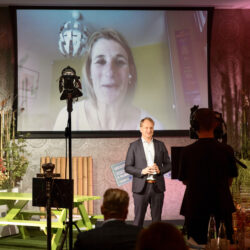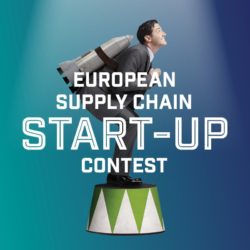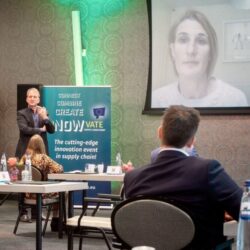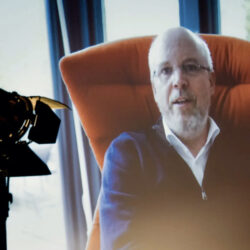Janet Godsell: “Use your authority and become a pathfinder”

How can we make our supply chains sustainable? That’s the question companies must answer over the next 15 years. “If we stick to our linear supply chains, we’ll create a world on the brink of collapse,” emphasized Janet Godsell in her keynote presentation during inNOWvate Supply Chain Event. She explained how companies can evolve into one of the pathfinders leading the way towards a different future in which consumption is no longer connected to production.
The industrial age has spanned a 250-year period of strong economic growth driven by consumption. “As various experts have said, including Sir Richard Attenborough, this link between consumption and production is now threatening to destroy our planet. If we want to move forward, we have to find new ways of meeting society’s needs. We will have to uncouple consumption from production,” said Janet Godsell (pictured, on screen), Professor of Operations and Supply Chain Strategy at the University of Warwick.
Godsell argued that the traditional linear supply chain – in which resources are extracted from the ground and turned into products that eventually end up in landfill – is no longer sustainable. “We need to keep those products in the state of greatest value for as long as possible. They should only be recycled when they can no longer be reused. The business models of the future must be designed with that in mind.”
Utopia or dystopia
Janet Godsell has worked with Blue Yonder to study how supply chains should look in 2035. She consulted a mind-boggling 600,000 data sources, and analysed 108 of them in depth. That yielded a list of 53 factors that can influence the response to societal developments. “We outlined two opposing scenarios: a utopia in which the world is thriving, and a dystopia – a world on the brink of collapse, which is what will happen if we ignore sustainability. That’s a frightening prospect, but it will come true if we continue to cling to the current linear economy.”
A dystopia is an extremely undesirable prospect, including from a supply chain perspective. Godsell painted a picture of fierce competition and rising costs for raw materials and manufacturing. “If we want the world to thrive, we will have to embrace the principles of the circular economy. This will lead to a very different industrial landscape with largely self-sufficient regions where there is less social inequality,” stated Godsell, who referred to this as ‘distributed manufacturing’.
Pathfinder or laggard
The question is, how can companies contribute to the creation of this thriving world? Godsell mentioned the two most important factors: the extent to which companies are able to adopt new industrial technologies, and the extent to which they can integrate supply chain partners. When visualized in a matrix, the pathfinders are positioned in the top-right quadrant and the laggards to the bottom left. “Of course, we want to minimize the number of laggards and encourage more companies to become pathfinders. The most convenient route to achieving that might be by moving to the upper-left or lower-right corner first, by becoming an integrator or a technophile. So companies should look at how they can strengthen their competencies in supply chain integration and the adoption of new technologies.”
As her keynote presentation progressed, Godsell explained the typical characteristics of companies in the four quadrants in more detail. She concluded with the message that supply chain professionals play an important role in transforming companies into pathfinders. Research by Gartner shows that supply chain professionals within 85% of businesses have the authority to make decisions related to the circular economy, either alone or together with other departments. “So seize that opportunity. Think about what future you want to pursue and use your authority to make it a reality.”
Carbon footprint
In the discussion at the end of inNOWvate Supply Chain Event, Sikko Zoer from Medtronic and Jeroen van Weesep from Lego were asked where their companies should be placed in the matrix: are they pathfinders or laggards? “If I’m honest, we’re still a laggard,” said Zoer. “But we’re ambitious and want to improve. This year we’ve set ourselves carbon footprint targets for the first time, for example, but we still have a long way to go.”
Lego is moving towards the integrator quadrant. Van Weesep: “We’re active in the world of plastics, but we’re looking for alternative materials that allow for reuse. And we realize that our supply chain has a carbon footprint – not just within Lego, but also outside of it. We’re working on that.”
One thing that hinders Lego is the number of legacy IT systems which make it impossible to analyse the total carbon footprint without a lot of manual work. The company is also aware of the need to introduce KPIs that are much more strongly focused on sustainability.
Zoer could identify with the message of Janet Godsell: “As Supply Chain, we have a lot of influence on decision-making within the company. At Medtronic, we already include sustainability in our considerations about supply chain design, but it will continue to become an increasingly important factor.”
Missed this event?
The recording is available on the YouTube channel of Supply Chain Movement. The slide deck is available for download below.










